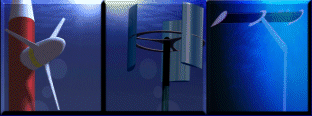|
Some Hydrodynamics |
|
| Comparisons |
|
|
Device Economics |
Technological Review
As part of the remit of this project, there is a requirement
to assess the relative performance of differing types of marine
energy conversion technologies. It is hoped that such a comparison
will provide information regarding suitability of technology types
to differing flow conditions encountered, with an end result of
finding the optimum.
However, it has been recognised that as marine power capture is
an emerging market, and there are, as yet, no clear market winners,
commercial confidentiality dictates that developers release scant
data pertaining to the performance of their products. Thus it
is proper that a more investigative approach be sought, with the
development of generic models being undertaken.
Due to the scarcity of data (on large scale marine devices), the
modelling approach has been from virtually first principles, and
it is hoped that the models themselves are amply rigorous as to
be sufficiently general that accurate modelling is possible for
many conditions and types, with no particular emphasis being placed
on the design of a particular manufacturer.
It is inevitable, however, that since this is not a design exercise
a certain similarity will exist between our models and actual
devices. The team are aware of this and it will be simply stated
here that there is no favour been granted to a particular commercial
design, and that any similarity that exists between such a type
and our own is purely a result of similar background research
undertaken.
A core constituent of this project is, as stated previously, a technological review, and as such a number of generic tidal energy capture devices have been examined. These broadly fall into 3 classes:
- Vertical axis turbines (VAMCTs)
- Horizontal axis turbines (HAMCTs)
- Oscillating hydrofoils
For all cases, in the widest sense, the principle of operation is the same: hydrodynamic forcing over some surface is translated into movement and thus useful work. In the case of the turbines, the surfaces are arranged to develop angular velocity about some shaft, and for the hydrofoil it is translational movement that is used to charge a pressure circuit from which power is taken. In all cases hydrodynamic principles discussed here apply.
Although the models developed may now be considered old-fashioned, they were for a long time absolute state of the art, and are still extensively used as a stage 1 analysis. They are perhaps more useful in providing a grounding in the physical properties and processes occurring during the use of the devices. It should be noted that all our models are based on rigid body kinematics; extension to elastic modelling can be incorporated by someone else with more time at a later date.

|
Some Hydrodynamics |
|
| Comparisons |
|
|
Device Economics |
Go back to Contents

 Home
Home 
